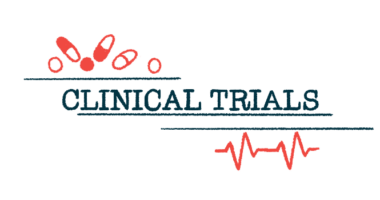Talquetamab Named a Breakthrough Therapy for Hard-to-treat Myeloma

Talquetamab, a first-in-class antibody treatment being developed by Janssen Research & Development, has been granted breakthrough therapy designation by the U.S. Food and Drug Administration (FDA) for hard-to-treat multiple myeloma.
The designation was awarded based on the positive safety and efficacy findings of a Phase 1/2 clinical trial involving adults with relapsed or refractory multiple myeloma (RRMM) who previously received at least four lines of therapy. Data showed that talquetamab helped kill cancer cells by targeting two specific proteins — GPRC5D and CD3 — at the same time.
The FDA awards breakthrough therapy designation to accelerate the development of investigational treatments for serious or life-threatening conditions. It is based on preliminary clinical evidence showing a therapy’s improvement on at least one clinically significant goal compared with existing treatments.
“This breakthrough therapy designation marks an important step in the continued development of talquetamab, a first-in-class bispecific antibody T-cell engager using GPRC5D, a novel target for the treatment of patients with relapsed or refractory multiple myeloma,” Sen Zhuang, MD, PhD, vice president of Janssen Research & Development, said in a press release.
“Despite the therapies available for patients with relapsed or refractory multiple myeloma, new targets and treatments are needed because of the heterogeneity of the disease, which can impact a patient’s response to treatment,” Zhuang said.
Talquetamab was designed to target the GPRC5Da receptor, which is highly present on cancerous plasma cells. It also binds CD3, a protein on the surface of immune T-cells. Preclinical studies demonstrated that talquetamab works by triggering the death of GPRC5D-expressing cells by binding and activating T-cells.
In humans, talquetamab was tested in the Phase 1/2 MonumenTAL-1 study, which recruited heavily pretreated adults with RRMM.
Phase 1 (NCT03399799) of MonumenTAL-1 was a dose-escalation study, in which participants were given increasingly higher doses of talquetamab to establish a safe dosing schedule. The therapy was delivered either intravenously (into the vein) or through an under-the-skin (subcutaneous) injection.
Researchers also assessed the safety of talquetamab and determined the best dose to be tested in the trial’s ongoing Phase 2 (NCT04634552).
Phase 2 is evaluating the efficacy of talquetamab in up to 320 adults with RRMM. Recruitment is continuing at 83 sites worldwide.
Findings from MonumenTAL-1 were presented during the 2022 European Hematology Association (EHA) Annual Congress and also shared at the 2022 American Society of Clinical Oncology (ASCO) Annual Meeting.
According to study findings, two recommended doses, both under-the-skin injections, were identified: 405 mcg (microgram)/kg weekly and 800 mcg/kg once every two weeks.
Participants in the 405 mcg/kg group had received a median of six prior lines of therapy, including a proteasome inhibitor, an immunomodulatory agent, and a CD38 inhibitor. Meanwhile, patients in the 800 mcg/kg group had received five prior therapies. Median follow-up was almost a year for those in the first group and about four months for those in the second.
Most of the reported adverse events (side effects) were mild or moderate in severity. A low blood cell count, called cytopenia, was among the most common adverse events, reported for 67% of patients in the 405 mcg/kg group and 36% of those in 800 mcg/kg group.
Cytokine release syndrome (CRS), a potentially life-threatening complication characterized by fever and multiple organ dysfunction, also was frequently observed. It occurred in 77% of those in the lower dose group and 80% of patients in the higher dose group.
Other common adverse events included infections (47% and 34%), skin- and nail-related disorders (83% and 75%), and dysgeusia, or an altered sense of taste (63% and 57%). No patients died as a result of an adverse event.
Overall response rates were 70% (405 mcg/kg group) and 64% (800 mcg/kg group), with 57% and 52%, respectively, achieving a very good partial response or better rate. The median time to the first confirmed response was about one month for both groups.
Both doses had similar profiles in terms of pharmacokinetics, the movement of a treatment throughout the body, and pharmacodynamics, the interactions between the body and a compound.
“We are resolute in our commitment to advance science and develop new therapies and regimens for patients with the goal of delivering the best possible outcomes while driving toward cures,” Zhuang said.
Talquetamab last year also received orphan drug status from the FDA. It also was granted priority medicines (PRIME) designation from the European Medicines Agency (EMA).







